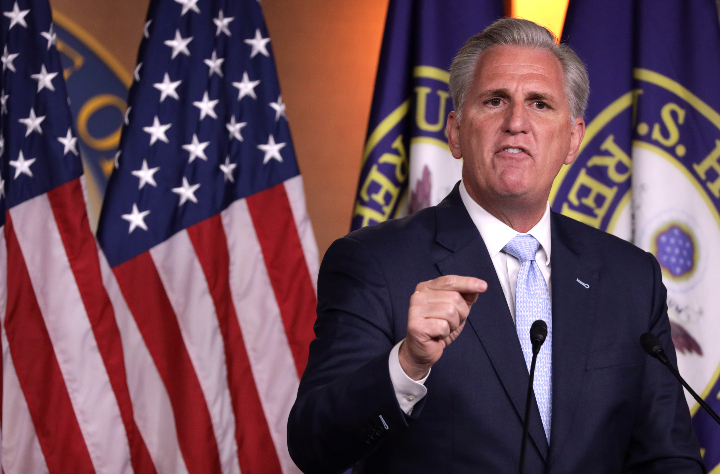Karl Evers-Hillstrom joined the Center for Responsive Politics in October 2018. As CRP's money-in-politics reporter, he writes and edits stories for the news section and helps manage a team of diligent writers. A native of Brooklyn, New York, Karl graduated from State University of New York at New Paltz in 2016 with a B.A. in journalism. He previously worked at The Globe, a regional newspaper based in Worthington, Minnesota. His email is kevers@crp.org.
-
House Minority Leader Rep. Kevin McCarthy (R-CA).
[Image source. Click image to open in new window.]
House Republicans' flagship super PAC is relying heavily on "dark money" funding from an allied nonprofit to bolster its reserves as it plans an aggressive push to reclaim the House.
The Congressional Leadership Fund has received nearly $20 million from American Action Network, a closely tied nonprofit that does not disclose its donors. That total -- which includes some in-kind contributions for research work -- makes up nearly one-third of the super PAC's fundraising this cycle. The Congressional Leadership Fund brought in over $7 million from its allied dark money group in June 2020 alone, according to new Federal Election Commission filings.
The cash boost comes as the super PAC readies a flurry of ads to boost Republican House candidates over their Democratic counterparts. The Congressional Leadership Fund plans to go on the offensive, reserving $43 million in Fall 2020 ads mostly targeting Democratic freshmen. Democrats hold a substantial majority in the House after flipping 41 seats in the 2018 midterms.
American Action Network launched its own $4 million issue ad campaign Thursday in support of House Republicans' drug pricing bill. The group's ads attack the drug pricing plan offered by House Speaker Nancy Pelosi (D-Calif.) and celebrates Republican lawmakers -- most of them in battleground districts -- who support the Republican bill.
Allied with House Minority Leader Kevin McCarthy (R-Calif.), the Congressional Leadership Fund has nearly $51 million in the bank to shell out on election ads. Its top targets include freshman Reps. Lizzie Fletcher (D-Texas), Anthony Brindisi (D-N.Y.), Kendra Horn (D-Okla.) and Joe Cunningham (D-S.C.), each of whom narrowly won their 2018 races, flipping seats long-held by the GOP.
Democrats, on the other hand, aim to expand their majority in November by heavily targeting races they barely lost. Their optimism is fueled by an immense fundraising advantage and generic congressional polls that show Democrats ahead of Republicans by an average of 8 points.
The Congressional Leadership Fund has already spent $4.5 million this cycle, significantly more than its Democratic counterpart, House Majority PAC. The Congressional Leadership Fund spent $1.3 million defending Rep. Kay Granger (R-Texas) from a primary challenge and another $2.4 million boosting Rep. Dan Bishop (R-N.C.) over Dan McCready in last year's all-time expensive special election.
The super PAC [Congressional Leadership Fund] spent $138 million to influence the 2018 midterms, with over $26 million of its funding coming from American Action Network. It's increasingly common for super PACs to take big money from dark money groups. Each of the leading super PACs tied to leaders of both parties in the House and Senate are bolstered by varying amounts of secret funds. As a result, direct dark money spending is down, but spending by outside groups that only partially disclose their true sources of funding is up.
Two super PACs supporting presumptive Democratic nominee Joe Biden recently took in millions from an influential dark money group. A pop-up super PAC that influenced Colorado's Democratic Senate primary revealed this week that it was actually funded by Majority Forward, a dark money group tied to Democratic leaders in the Senate.
Return to Persagen.com
